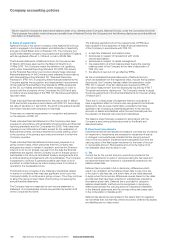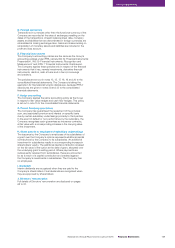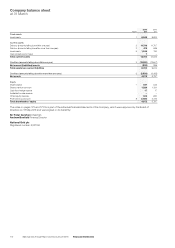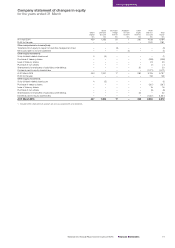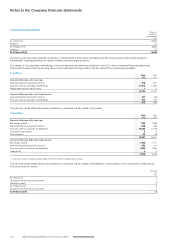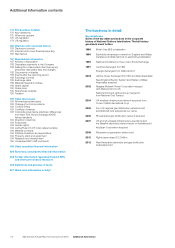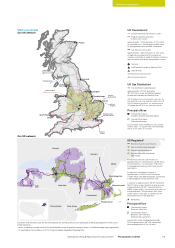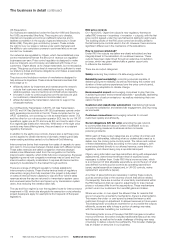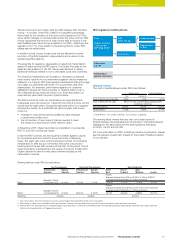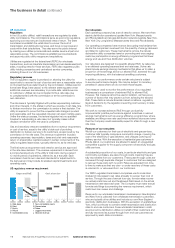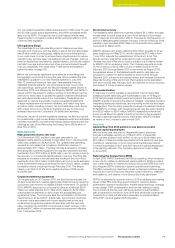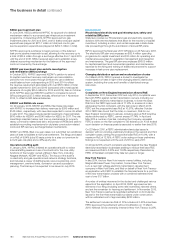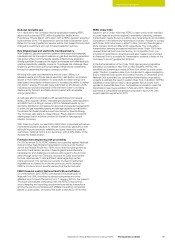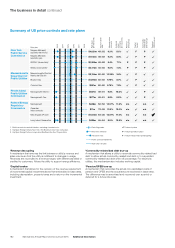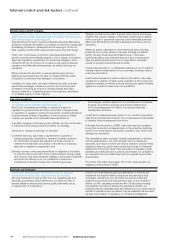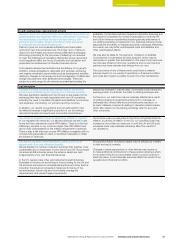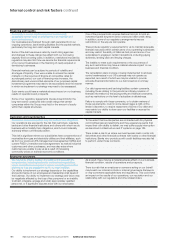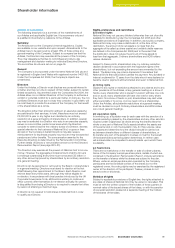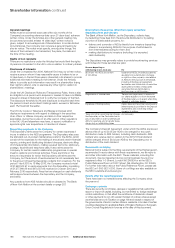National Grid 2016 Annual Report Download - page 180
Download and view the complete annual report
Please find page 180 of the 2016 National Grid annual report below. You can navigate through the pages in the report by either clicking on the pages listed below, or by using the keyword search tool below to find specific information within the annual report.
A B C D E F G H I J
Capex and RoE Cost of service
A Rate base
B Debt
C Equity
D Return
E Controllable costs
F Non-controllable costs
G Depreciation
H Taxes
I Lagged recoveries
J Allowed revenue
X allowed
RoE
X cost
of debt
RoE
Interest
US Regulation
Regulators
In the US, public utilities’ retail transactions are regulated by state
utility commissions. The commissions serve as economic regulators,
approving cost recovery and authorised rates of return. The state
commissions establish the retail rates to recover the cost of
transmission and distribution services, and focus on services and
costs within their jurisdictions. They also serve the public interest
by making sure utilities provide safe and reliable service at just and
reasonable prices. The commissions establish service standards
and approve public utility mergers and acquisitions.
Utilities are regulated at the federal level (FERC) for wholesale
transactions, such as interstate transmission and wholesale electricity
sales, including rates for these services. FERC also regulates public
utility holding companies and centralised service companies,
including those of our US businesses.
Regulatory process
The US regulatory regime is premised on allowing the utility the
opportunity to recover its cost of service and earn a reasonable return
on its investments as determined by the commission. Utilities submit
formal rate filings (‘rate cases’) to the relevant state regulator when
additional revenues are necessary to provide safe, reliable service
to customers. Utilities can be compelled to file a rate case due
to complaints filed with the commission or at the commission’s
own discretion.
The rate case is typically litigated with parties representing customer
and other interests. In the states in which we operate, it can take nine
to thirteen months for the commission to render a final decision. The
utility is required to prove that the requested rate change is prudent
and reasonable, and the requested rate plan can span multiple years.
Unlike the state processes, the federal regulator has no specified
timeline for adjudicating a rate case, but typically makes a final
decision retroactive when the case is completed.
Gas and electricity rates are established from a revenue requirement,
or cost of service, equal to the utility’s total cost of providing
distribution or delivery service to its customers, as approved by the
commission in the rate case. This revenue requirement includes
operating expenses, depreciation, taxes and a fair and reasonable
return on shareholder capital invested in certain components of the
utility’s regulated asset base, typically referred to as its rate base.
The final revenue requirement and rates for service are approved
in the rate case decision. The revenue requirement is derived from
a comprehensive study of the utility’s total costs during a recent
12 month period of operations, referred to as a test year. Each
commission has its own rules and standards for adjustments to
the test year and may include forecasted capital investments and
operating costs.
US regulatory revenue requirement
Our rate plans
Each operating company has a set of rates for service. We have three
electric distribution operations (upstate New York, Massachusetts
and Rhode Island) and six gas distribution networks (upstate New York,
New York City, Long Island, Massachusetts (two) and Rhode Island).
Our operating companies have revenue decoupling mechanisms that
de-link the companies’ revenues from the quantity of energy delivered
and billed to customers. These mechanisms remove the natural
disincentive utility companies have for promoting and encouraging
customer participation in energy efficiency programmes that lower
energy end use and thus distribution volumes.
Our rate plans are designed to a specific allowed RoE, by reference
to an allowed operating expense level and rate base. Some rate
plans include earnings sharing mechanisms that allow us to retain a
proportion of the earnings above our allowed RoE, achieved through
improving efficiency, with the balance benefiting customers.
In addition, our performance under certain rate plans is subject
to service performance targets. We may be subject to monetary
penalties in cases where we do not meet those targets.
One measure used to monitor the performance of our regulated
businesses is a comparison of achieved RoE to allowed RoE.
However, this measure cannot be used in isolation, as there are a
number of factors that may prevent us from achieving the allowed
RoE. These factors include financial market conditions, regulatory
lag and decisions by the regulator preventing cost recovery in rates
from customers.
We work to increase achieved RoE through: productivity
improvements; positive performance against incentives or earned
savings mechanisms such as energy efficiency programmes, where
available; and filing a new rate case when achieved returns are lower
than the Company could reasonably expect to attain through a new
rate case.
Features of our rate plans
We bill our customers for their use of electricity and gas services.
Customer bills typically comprise a commodity charge, covering the
cost of the electricity or gas delivered, and charges covering our
delivery service. With the exception of residential gas customers in
Rhode Island, our customers are allowed to select an unregulated
competitive supplier for the supply component of electricity and gas
utility services.
A substantial proportion of our costs, in particular electricity and gas
commodity purchases, are pass-through costs, meaning they are
fully recoverable from our customers. These pass-through costs are
recovered through separate charges to customers that are designed
to recover those costs with no profit. Rates are adjusted from time
to time to make sure that any over- or under-recovery of these costs
is returned to, or recovered from, our customers.
Our FERC-regulated transmission companies use formula rates
(instead of rate cases) to set rates annually to recover their cost of
service. Through the use of annual true-ups, formula rates recover
our actual costs incurred and the allowed RoE based on the actual
transmission rate base each year. The Company must make annual
formula rate filings documenting the revenue requirement, which
customers can review and challenge.
Revenue for our wholesale transmission businesses in New England
and New York is collected from wholesale transmission customers,
who are typically other utilities and include our own New England
electricity distribution businesses. With the exception of upstate New
York, which continues to combine retail transmission and distribution
rates to end-use customers, these wholesale transmission costs
are incurred by distribution utilities on behalf of their customers and
are fully recovered as a pass-through from end-use customers as
approved by each state commission.
178 National Grid Annual Report and Accounts 2015/16 Additional Information
The business in detail continued


